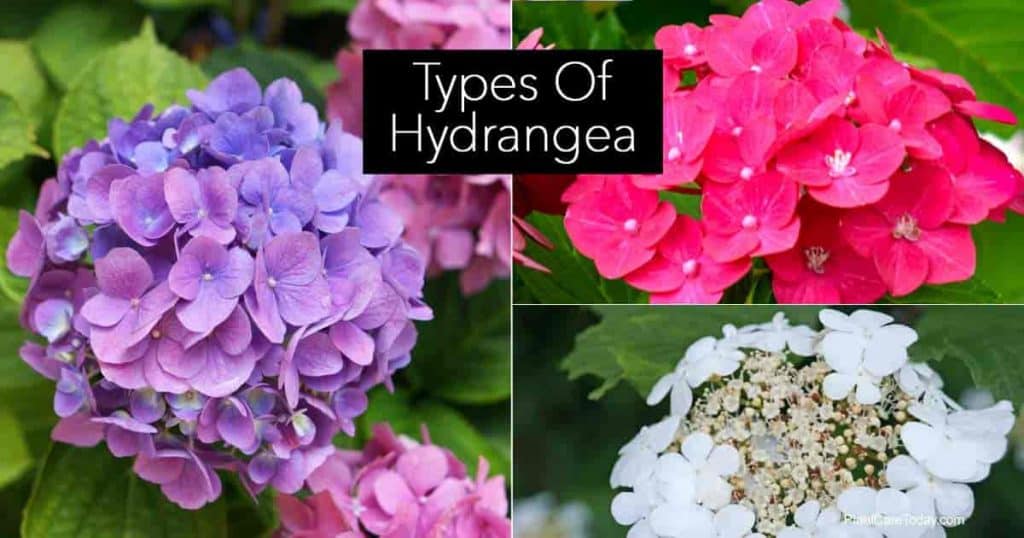There are about two dozen different types of hydrangeas, but only about half a dozen are widely available in the United States. These choices can be divided into two categories.
The first category is made up of plants that will bloom on stems from the current season (new growth). The second category is made up of plants that only bloom on established, woody stems (growth from the previous year).

As you will soon learn there are two flower types of hydrangeas – the mophead and the lacecap.
What’s The Difference Between a Lacecap or Mophead Hydrangea?
The most popular type is mophead. Showy and loved for their voluptuous softball size blooms, filling the landscape with head-turning pink, white and blue flowers.
The flower heads of lacecap hydrangeas have more of a dome shape but stunning just the same as they call butterflies and bees for a visit.
Learn Tips on Hydrangea Care here and Dombeya Seminole – The Florida Hydrangea

Hydrangea Category #1 – Plants Blooming On Current Season Growth
These types of hydrangeas form buds on current year growth in the early summer. Hydrangea blooms reliably and profusely year-after-year even in very cold climates. Here are three of the most reliable, top-performers:
Panicle hydrangeas (paniculata)
These plants hail from Asia and are hardy in the USDA hardiness zones 3 through 7. The plants can grow to reach fifteen feet high and produce abundant, cone-shaped panicles of creamy white blossoms. The panicles range in size from six to eighteen inches long.
The most popular cultivar is Panicle Grandiflora (aka P.G. or PeeGee Hydrangea). These plants grow very easily, making them an excellent and satisfying choice for beginning gardeners. They do well in a mixed border, planted as a hedge or pruned to grow as a tree.
Another popular cultivar is the dwarf Little Quick Fire Hydrangea.

Smooth hydrangeas (arborescens)
This variety is hardy from USDA hardiness zones 3 through 9.
It does very well when planted in cold climates, and it is sometimes nicknamed “Snowballs” both because of its cold resistance and its large, showy white blossom clusters.
The most common cultivar of Hydrangea arborescens is ‘Annabelle,’ produces clusters of white blossoms that can measure one foot across.
As the blooms age, they take on a greenish hue.
French Hydrangea (macrophylla) or Hydrangea serrata
This plant is a small, subspecies that presents a delicate appearance. The leaves and flowers of these plants are a bit smaller than those of other varieties.
Flowers may grow in either lace-cap or mop-head formation and make excellent additions to dried flower arrangements. This variety does well planted as an under-story for large trees.
Hydrangea Category #2 – Plants Blooming On Previous Year Growth
These plants bloom on older, woody growth, so it is important that the old wood from the previous season survive through late winter. For this reason, choose from these varieties only if you live in an area with mild winters. Here are three excellent choices:

Oakleaf hydrangea (quercifolia)
This variety is a US native found growing wild in the woodlands of the southeastern United States.
These medium-sized shrubs grow to between six and eight feet high and produce panicles of white, creamy blooms ranging from four to twelve inches long.
These plants are bud-hardy to zone 5.
Oakleaf hydrangea is so-called because of its interestingly shaped leaves, which put on a lovely show of color in the autumn.
The blooms also go through an impressive color transformation and often turn an intense shade of rose or brown during the fall months.
After the leaves have fallen, in fall, the textured bark and dried blooms add winter interest. The most popular oak-leaf cultivars are:
- Alice
- Snowflake
- Snow Queen

Known as the French hydrangea, like the Mountain hydrangea, the big leaf variety also comes in two flower shapes. Choose from mophead or lacehead.
The mophead Hydrangea variety is Hortensia, (Hydrangea macrophylla var. macrophylla).
This native of Japan is hardy to zone 6. It blooms early in the summer, producing showy balls in bloom color shades of white, pink and blue. Some of the best choices are:
- All Summer Beauty
- Nikko Blue

Lacecap hydrangea varieties (Hydrangea macrophylla var. normalis) are cold hardy from USDA hardiness zones 5 to zone 9. The plant produces flat-topped, lacy flower clusters made up of a circle of tiny, fertile flowers surrounded by a ring of larger, showy blooms.
Both mop-head and lace-cap varieties grow to be four to six feet tall. They make an excellent choice for mass planting, borders or on their own as specimen plants. Blue Wave is one of the most popular of the lacecap Hydrangea choices.
Climbing hydrangea (anomala or petiolaris)
An interesting and impressive plant, rugged and hardy from USDA zones 4 to zone 7. While they do take a while to become established, once started, they can be a bit hard to stop as they climb and spread to heights and widths in excess of eighty feet.

These plants do well in a wide variety of light conditions ranging from shade to full sun. Blossoms appear in mid-summer and are lace-capped in creamy white. Leaves are dark, glossy and attractive.
The vines can leave a sticky residue on the surfaces to which they cling. For this reason, you may prefer to have your plant climb a trellis, rock-pile, tree or fence rather than having it climb your house. [source]
